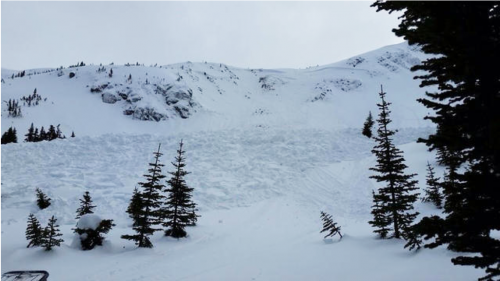Large Avalanches in the North Rockies
There has been a cluster of unexpected, large avalanches in the North Rockies region. Sadly, one of these resulted in a fatality. Here are some details on the three events that we have been made aware of:

There is a report and pictures of this incident here. Details are scarce. The general orientation of Benny’s Bowl is north. It’s most likely the slope in question was either north or northwest facing. Based on the photos, the avalanche appears to have run on a deep weak layer – possibly an early crust based on the sheen that is evident over some of the rocky outcrops. In the centre of the crown, there is a very prominent area where the crown tapers from thick to thin. This indicates that recent wind drifting had affected this area. This kind of wind loading creates differential shallow and deep areas on the slope. Avalanches are usually more easily triggered from shallow spots on the slope, while the presence of deeper areas can add significant mass.
Sunday 22-Feb: Turbo Hill, Kakwa
A close call occurred on Turbo Hill, where two riders in close proximity triggered an avalanche while ascending the slope. One rider was fully buried and successfully rescued by a companion member of their group. This was an alpine feature, but we do not have details about aspect, or what weak layer the avalanche failed on. We heard there had recently been 5-10 cm new snow with some strong winds. At the time of the incident, the weather was fine and the sun was shining.
Updated: The aspect was southeast. The group felt as though the avalanche occurred in recent storm snow. Total run distance was approximately 200 m.
Sunday 22-Feb: Superbowl, Core Lodge area, near Tumbler Ridge
A fatality occurred on a convex-shaped NE aspect slope at upper treeline elevation as a party was descending down a steep slope into a riding area. Three snowmobilers were caught in the avalanche. Two were successfully rescued by members of their group, while a third succumbed to his injuries. The avalanche crown was reported to be 150-200 cm deep. The avalanche is suspected to have released on a weak layer from mid-December that was resting over the top of an ice crust. Heavy loading with wind-blown snow was also reported in this area.
RCMP press report here
Analysis:
It is hard to know how closely these avalanches are related. Certainly there are similarities in some of the physical snowpack characteristics, at least between the event in Morfee Mountain and the one in the Core Lodge area. Both incidents occurred in shady aspects close to, or in the alpine. Both areas were reported to have had wind-drifted snow. Both avalanches released on a weak layer at or near the base of the snowpack. Both incidents involved parties with more than one person on the slope.
I think these incidents highlight the need to maintain safe travel procedures and only to expose one person on an avalanche slope at any one given time. Other members of the group need to wait for the person on the slope to exit it from a safe spot well back from the base of the slope, preferably off to the side.
Given these recent large avalanches, I would be nervous of pushing into steep terrain, especially on northerly aspects in the alpine at this time. On these aspects, the hard crusts that appear to be holding the upper snowpack layers together at lower elevation and on more southerly aspects are not as well formed. The possibility of triggering a similar event increases with large triggers (multiple people riding on the same slope, or jumping off a cornice), with recent wind loading (a small wind slab avalanche can trigger a deeper layer below), and when the sun comes out and/or temperatures climb.
James Floyer











Comments